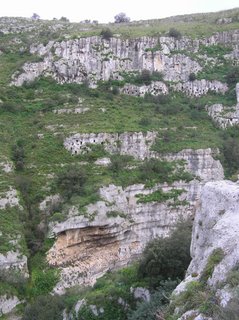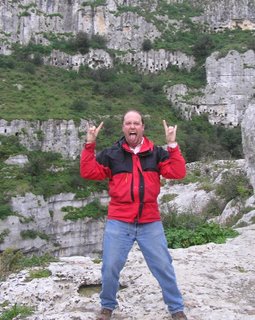I've been thinking a lot about fish lately, prompted by a project I'm beginning on fish in Roman culture and literature. It's not a bad thing to work on here, since it gives me the excuse to do some research on fish in modern Italy. By "research", of course, I mean mostly "eating"-- but I've been looking into fish in other ways as well.
You wouldn't think it from visiting coastal Italy (or, for that matter, an inland city like Rome), but the Mediterranean is actually relatively fish-poor, at least compared to the ocean. Modern fishing techniques mean that it's not too hard to get a variety of fish to market. But some parts of the peninsula have historically had better access to fish than others, and that access is reflected on a consumer level by the presence of large fish markets. I'm going to look at two of these, from opposite ends of Italy.
The first of these is pretty famous, the Rialto fish market in Venice. Venice's lagoon, with its shallow, brackish water, is a great environment for attracting the wide variety of fish that are the hallmark of Venetian cuisine. The importance of fish for Venice is highlighted by the elegant architecture of the market.

The structure, built in 1907, is a wide portico with room for two rows of stalls, facing onto the Grand Canal. It's easily the loveliest fish market I've ever seen (okay, not that much competition there...) The column capitals along the outside are all in the shape of different fish, boats, etc.:

I didn't see any turtles for sale at the market! But these guys are pretty cute. The architect (whom my guidebook lists as the painter Cesare Laurenti) was clearly having some fun, while maintaining a traditional Venetian appearance.
As the city of Venice has shrunk (there are about 60,000 people in central Venice, down from 200,000 a century ago), the importance of the market has decreased. Restaurants buy a lot of fish, of course, but they mostly get it from the wholesale market, and while tourists might buy an apple or cherries, a whole mackerel or bag o' shrimp doesn't tend to fit well into a suitcase! As a result, when I was there (late May), the market was only about half-occupied by stalls, and many of the people walking around were (like me) tourists with cameras, rather than shoppers.
Too bad, because the seafood there is absolutely gorgeous. I'm pretty bad with seafood names (in English or Italian)- so please feel free to help me out in comments... Here's one I do know, some nice looking red mullets:

They're particular favorites of mine, both because the Romans loved 'em (as pets and as food), and because, hey: "red mullet". hee!
There's a lot of care put into displaying fish (it helps that I arrived at around 8 AM, when things were just starting to gear up):

Here are some canocce: alien-looking crustaceans that are very characteristic of Venice. I don't know if they live elsewhere:

I love those "eyes". This is a close-up, obviously, but lots of the vendors stack them up like so much fishy cordwood. We had canocce for dinner that night (at Alle Testiere); they're sweet and tender, sort of between really fresh Gulf shrimp and crab.
Here's a bucket o' eels:

Still alive: that one in the center was flapping its gills and glaring balefully at me. I have to admit something here and say that eels squick me out a little, and this guy didn't really change things for me...
The fruit and vegetable market is right next to the fish market. There's a nice selection, but it didn't strike me as especially distinctive:

Hey you! Get back to the piazza San Marco! (And memo to shoppers: be sure to wash that eggplant well!
The other fish market I've visited that really impressed me was way at the other end of Italy, in Syracuse. Sicilian seafood is of course famous, and rightly so. Like Venice, Sicilians have been able to exploit their environment to get access to lots of different kinds of seafood. In this case, the straits of Messina provide naturally good fishing grounds. The small space creates a difference in temperature between the western and eastern Mediterranean, something that attracts fish. And the narrow straits funnel fish, making them easier to catch.
The market in Syracuse is on the island of Ortygia, steps away from the temple of Apollo and next to the small harbor. It stretches for about two or three blocks on a small street. Not as picturesque as the Venice market, but with at least as good a selection of fish, and with a more vibrant atmosphere.
Here are some anchovies. Or maybe sardines. I'm not really sure, actually:

To misquote Maurice Chevalier, "thank heaven for leetle feesh!" I've really come to love the miniature members of the scaly tribe: alici sott'olio? Oh yeah. It's a real shame that Americans are so fixated on steak fish (salmon, tuna, etc.); I'm sure whether I'll be able to get them back in the US. Anyway, it's an excuse to eat as many as possible now...

I don't know what this thing is. But it kind of scares me. Probably it's delicious, but I wouldn't have the faintest idea what to do with it. Other than back away slowly...

Again, not really sure what these are. I just think they're really beautiful. As with these:

Let's just call those last photos "two studies in stripes."
Finally, the biggest fish in the market that day, a nice-looking tuna:

Everybody is impressed (and rightly so), even that kid in the corner. Yum!
I love Syracuse; it's a beautiful, friendly city with wonderful food and a fascinating history. One of my fantasies-- once I win the lottery, you know-- is to move there and just cook fish every single day. Someday, maybe...





